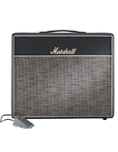Marshall 1974X Combo Guitar Amp

Manufactured from 1966 to 1968, the model 1974 (1974 is the model number, not the year it was made) was an 18-watt 1x12 combo with tremolo. It just may be the holy grail of low-wattage Marshall combos, providing classic Marshall attitude and aggressive growl, but at lower volume, of course. The 1974’s cosmetics are similar to those of the model 1962 “Bluesbreaker” 45-watt combo made famous by Eric Clapton, from the grey-and-white-striped grille cloth to the gold Marshall logo. Hence, it is often called the “mini Bluesbreaker,” a distinction it earns for its looks and stellar tone.
Over the years, the word about these mini brutes leaked out, and these days original 1974 combos sell for thousands of dollars, if you’re lucky enough to find one. Fortunately, Marshall paid attention to the buzz and have added the 1974X model to its acclaimed line of handwired reissue amps. This is not a limited-edition reissue but a regular production model that will hopefully remain in Marshall’s product line for a while.
Features
The 1974X is a faithful reproduction of the original 1974. It features the same circuit built around two EL84 power tubes, three ECC83 preamp tubes and an EZ81 rectifier tube. The amp has two channels, each of which has two inputs, a tone control and a volume control. One channel includes a tremolo circuit with corresponding speed and intensity controls. The 1974X is constructed with Dagnall output and mains transformers tweaked to the same specs as the original transformers, a point-to-point-wired tagboard circuit, a gold silk-screened Plexiglas control panel and an aluminum chassis, just like the Sixties version.
A single 20- watt 12-inch Celestion G12M-20 “Greenback” reissue T1221 speaker is housed in the amp’s Baltic birch-ply cabinet. According to Marshall, these speakers are “preaged,” using a special proprietary process, to match the tone and responsiveness of the original late- Sixties Greenbacks at age 35. Should you need more volume output, Marshall offers the matching 1974CX 1x12 extension cabinet for $1,000.

As you might expect for an accurate reissue of a classic amp, modern features are few and far between on the 1974X, if not altogether nonexistent. Although it has two channels, the 1974X has no channel switching, and the included footswitch only turns the tremolo circuit on and off; there is no master volume or multiband EQ either. Marshall did add a 4/8/16-ohm impedance switch and placed the HT—“High-Tension” (i.e., high-voltage)—and mains fuses on the chassis where you can easily access them. As tone purists will attest, this is the way it should be, as the addition of a master volume or three-band EQ would only take away from the 1974X’s pure, unadulterated tone.
Performance
All the latest guitar news, interviews, lessons, reviews, deals and more, direct to your inbox!
The 1974X’s simple circuit is actually a benefit, as it offers the bare essentials needed to boost your guitar’s signal without its tonal intricacies and personality getting lost. It’s like a mainline from your strings to the speakers, with just the right amount of overdrive/distortion thrown in for added color and oomph. Unlike many modern amps, which seem to use guitars primarily as sound on/off switches, the 1974X lets a Les Paul actually sound like a Les Paul, a Strat sound like a Strat, and so on. The tremolo channel has a little more “girth,” and the tone controls increase or decrease treble as a supplement to the amp’s harmonically rich midrange.
- With a dual-humbucker Les Paul, the amp’s signal starts breaking up with bluesy overdrive when the volume is at 4, and cranked all the way up it provides gnarly crunch that would make Angus Young drop his schoolboy shorts. If you need even more tonal variety, you can cascade the two channels together by connecting a jumper cable between the lower (lowsensitivity) input of the tremolo channel and one of the other channel’s inputs. Plug your guitar into the tremolo channel’s top (high-sensitivity) input and you can mix both channels together. This approach provides tone that’s dripping with fat midrange, satisfying sustain and that distinctive lowend tube rectifier sag when you hit the strings hard, like Clapton’s legendary lead tone on the 1966 Blues Breakers album.

The 1974X is not an overly loud amp, but its restrained volume output makes it ideal for recording or for playing small club gigs where you want all the glory of power tube distortion without making your ears bleed. Throw a mic in front of it, boost it through a PA and your audience will be none the wiser (although your lower back muscles will thank you).
The Bottom Line
Marshall took its sweet time reissuing an amp that tone geeks have clamored for over the past 15 years or so (18watt.com is just one of several websites devoted to these mini wonders), but thankfully they really got it right. At more than $175 per watt, it’s not exactly cheap, but these days few amps offer such gloriously pure tone. For classic Marshall aficionados, the 1974X may be the ultimate recording amp, providing gorgeous Marshall distortion at an SPL that won’t fry your expensive studio mics. When it comes to tone like this, the 1974X may be small and lightweight, but it’s as big, fat and heavy as it gets.
Chris is the co-author of Eruption - Conversations with Eddie Van Halen. He is a 40-year music industry veteran who started at Boardwalk Entertainment (Joan Jett, Night Ranger) and Roland US before becoming a guitar journalist in 1991. He has interviewed more than 600 artists, written more than 1,400 product reviews and contributed to Jeff Beck’s Beck 01: Hot Rods and Rock & Roll and Eric Clapton’s Six String Stories.

